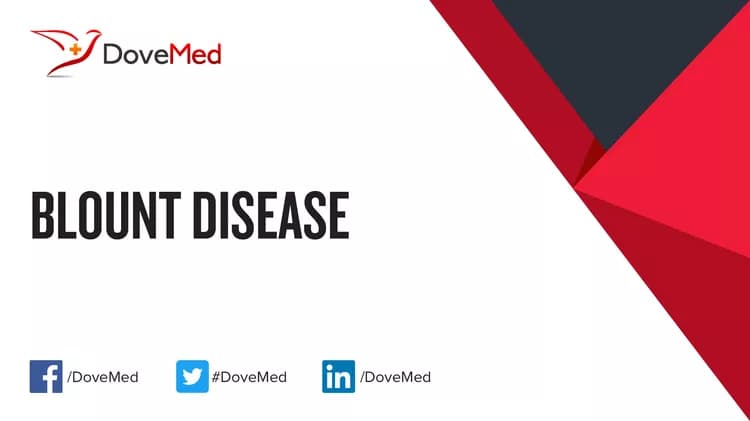What are the other Names for this Condition? (Also known as/Synonyms)
- Blount-Barber Syndrome
- Osteochondrosis Deformans Tibiae, Familial Infantile type
- Tibia Vara
What is Blount Disease? (Definition/Background Information)
- Blount Disease is a growth disorder of the shin bone (tibia) characterized by inward turning of the lower leg (bowing) that slowly worsens over time. While it is not uncommon for young children to have bowed legs, typically the bowing improves with age
- There are two types of Blount Disease (early-onset and late-onset), based on whether symptoms begin before or after four years of age
- Blount Disease may occur in one or both legs and can lead to shortening of the affected leg and other changes within bones of the legs
- The cause of Blount Disease is not well understood; however, a variety of hereditary and genetic factors are likely involved
- The condition is more common among certain populations and is associated with obesity and early walking
- Treatment may involve bracing and/or surgery
(Source: Blount Disease; Genetic and Rare Diseases Information Center (GARD) of National Center for Advancing Translational Sciences (NCATS), USA.)
Who gets Blount Disease? (Age and Sex Distribution)
- Blount Disease is a rare congenital disorder. The manifestation of symptoms may be noticed before or when the child reaches the age of four
- Both males and females may be affected
- Worldwide, individuals of all racial and ethnic groups may be affected
What are the Risk Factors for Blount Disease? (Predisposing Factors)
- Currently, no risk factors have been clearly identified for Blount Disease
- A positive family history may be an important risk factor, if Blount Disease is inherited
It is important to note that having a risk factor does not mean that one will get the condition. A risk factor increases one’s chances of getting a condition compared to an individual without the risk factors. Some risk factors are more important than others.
Also, not having a risk factor does not mean that an individual will not get the condition. It is always important to discuss the effect of risk factors with your healthcare provider.
What are the Causes of Blount Disease? (Etiology)
- The cause of Blount Disease is not well understood; however, a variety of hereditary and genetic factors are likely involved
- The condition is more common among certain populations and is associated with obesity and early walking
(Source: Blount Disease; Genetic and Rare Diseases Information Center (GARD) of National Center for Advancing Translational Sciences (NCATS), USA.)
What are the Signs and Symptoms of Blount Disease?
The signs and symptoms of Blount Disease may include:
- Abnormality of the proximal tibial epiphysis
- Genu varum
- Osteochondritis Dissecans
- Very frequently present symptoms in 80-99% of the cases: Abnormality of the metaphysis
(Source: Blount Disease; Orphanet, National Institute of Health and Medical Research (INSERM), Paris.)
How is Blount Disease Diagnosed?
Blount Disease is diagnosed on the basis of the following information:
- Complete physical examination
- Thorough medical history evaluation
- Assessment of signs and symptoms
- Laboratory tests
- Imaging studies
- Biopsy studies, if necessary
Many clinical conditions may have similar signs and symptoms. Your healthcare provider may perform additional tests to rule out other clinical conditions to arrive at a definitive diagnosis.
What are the possible Complications of Blount Disease?
The complications of Blount Disease may include:
- Walking difficulties
- Decreased quality of life
Complications may occur with or without treatment, and in some cases, due to treatment also.
How is Blount Disease Treated?
There is no cure for Blount Disease, since it is a genetic condition. The treatment is usually given to manage the signs and symptoms and any complications that develops. This may include surgical correction and use of braces.
How can Blount Disease be Prevented?
Currently, Blount Disease may not be preventable, since it is a genetic disorder.
- Genetic testing of the expecting parents (and related family members) and prenatal diagnosis (molecular testing of the fetus during pregnancy) may help in understanding the risks better during pregnancy
- If there is a family history of the condition, then genetic counseling will help assess risks, before planning for a child
- Active research is currently being performed to explore the possibilities for treatment and prevention of inherited and acquired genetic disorders
Regular medical screening at periodic intervals with tests and physical examinations are recommended.
What is the Prognosis of Blount Disease? (Outcomes/Resolutions)
- The prognosis of Blount Disease is dependent upon the severity of the signs and symptoms and associated complications, if any
- Individuals with mild conditions have better prognosis than those with severe symptoms and complications
- Typically, the prognosis may be assessed on a case-by-case basis
Additional and Relevant Useful Information for Blount Disease:
Blount Disease is also known by the following terms:
- Erlacher-Blount Syndrome
- Osteochondrosis Deformans Tibiae
The following DoveMed website link is a useful resource for additional information:
Related Articles
Test Your Knowledge
Asked by users
Related Centers
Related Specialties
Related Physicians
Related Procedures
Related Resources
Join DoveHubs
and connect with fellow professionals


0 Comments
Please log in to post a comment.